Introduction
Transitional economies have diverging paths of economic development and growth. Some economies experience tremendous growth with overcoming corruption and increasing their institutional quality, e.g., Singapore; while others remain in the backlash and experience lower growth rates often perceived because of the lack of institutional quality, e.g., African states, Sri Lanka, Southeast European countries. The focus of this paper is on the Southeast European countries that underwent transition from planned economies until the beginning of the 1990s to market economies thereafter. These Southeast European countries are the former SFR Yugoslavian member states. The Independence Wars of Bosnia and Herzegovina, Croatia and Slovenia, made an impact on their respective economies, while Montenegro, North Macedonia and Serbia did not. Furthermore, Croatia and Slovenia joined the European Union in 2013 and 2004 respectively. Hence, this paper attempted to examine the link between strategic networking antecedents: (1) trust and reputation, (2) cooperation and communication, and (3) commitment, and institutional quality: (a) competitiveness, (b) ease of doing business, and (c) ease of financing, to answer how do strategic networking antecedents affect institutional quality in, nowadays, two diverging institutional environments (European Union and non-European Union) (e.g., Cohen 2014; Peng &Heath, 1996; Battilana et al., 2009; Waeger & Weber, 2019).
The structure of the paper depicts the literature with proposed hypotheses in the next section followed by methodology and data section. Methodology and data section explain data collection method and the nature of the variables. Results of the weighted least square regressions are presented in subsequent section, while conclusion with policy implications and limitations of the study are developed thereafter.
Literature Review and Hypothesis
Institutional entrepreneurship theory which emerged from the institutional theory was used as a starting point for the analysis of the concepts covered in this paper. Institutional entrepreneurship theory explains the actions of agents affecting change in contemporary institutions (Maguire et al., 2004; Tiberius et al., 2020). Institutional entrepreneur, as one of such agents, is often characterised as a goal-driven, whose quality of insight into the institutional framework enables him to recognise prospect for change and influence institutional change (Hardy & Maguire, 2017). Institutional entrepreneurs’ social skills enable them to interact with the public institutions and incite and exploit institutional transition (Su, 2020). There are many examples of such endeavours, however, one of the contemporary and interesting examples is the case of Uber where the company attempted to make changes in the Netherlands taxi law (Pelzer et al., 2019).
Previous research explicated that Central and Eastern European economies should be analysed as particular economies rather than one single area (Meyer & Peng, 1996). The focus of this paper is placed on examining the differences between European Union and Western Balkan countries originated from the fallout of the former SFR Yugoslavia. Namely, divergence in institutional environments after 1990s occurred in the geographic area of former SFR Yugoslavia that exemplified Europeanisation on two levels. In terms of economic markets, Europeanisation shaped formal institutions with strong capacities of market regulation, administrative and planning capabilities (Bruszt, 2011). One level included accession of Croatia and Slovenia into the European Union, while the others remained on the outskirts of the European Union (Bosnia and Herzegovina, Montenegro, North Macedonia, and Serbia). Therefore, adhering to the previous, the focus of this paper is placed on examination of how informal networks affect formal institutions rather than substitute them in cases when they are weak (Ahlstrom & Bruton, 2006). The rationale comes from the research that shows how low level of SMEs networking influences divergence from institutional status quo (Battilana & Casciaro, 2012).
Moreover, institutional environment has an important role in explaining managers’ risk-related decisions (Makhija & Stewart, 2002). Some researchers inspected the role of business financing in terms of managerial risk-averseness in transition economies (Ahlstrom & Bruton, 2006; Whitley, 1999). Whitley (1999) distinguishes between capital market and credit-based system which forms a crucial aspect of institutional business environment. He also explains eight dimensions of comparison of business environment based on ownership, non-ownership coordination and employment relations and work management. These types of business environments can be associated with firms’ networking behaviour. Subsequently, Whitley (1999) differentiates , among others, between state-organised and collaborative business environment, stating that state-organised is dominated by large firms who obtain credit by the state and often use vertical networking and ownership integration, while collaborative business environment is characterised by cooperation between sectors and non-ownership integration. In terms of venture capital, the role of informal institutions, such as networking, diminishes as formal institutions become more established (Ahlstrom & Bruton, 2006).
Many definitions of interorganizational networking can be found in the literature (Eckenhofer, 2011; Thornton, Henneberg & Naudé, 2013; Fayoyin, 2017) depicting various organizational forms explaining the concept of networks and networking among SMEs. Network as a concept can be defined as a specific set of relationships between different groups, and according to this approach, networks primarily represent a group which can form specific types of relationships (Curran et al, 1993; Donckels and Lambrecht, 1995; Miller, Besser & Malshe, 2007; Connelly, Bryant & Sharp, 2020). In the SME context, Human and Provan (1997) define strategic networks as geographically close intentionally formed groups of companies which operate in the same industry, and exchange inputs and outputs, with the aim of achieving certain business objectives. Due to their proximity, companies are capable of realizing key competencies and resources with the purpose of achieving such goals which they would not be able to achieve on their own (Carson, Gilmore & Rocks, 2004; Thornton, Henneberg & Naudé, 2013). Thus, the purpose of strategic network is to form a forum for direct and indirect business activities where members provide their inputs and at the same time harvest the benefits of using the other members’ outputs (Wincent & Westerberg, 2005; Thornton, Henneberg & Naudé, 2013). Therefore, cooperation and exchange are the foundation for creating value and in turn improving firm competitiveness (Human and Provan, 1997; Miller, Besser & Malshe, 2007). On the other hand, participation in strategic network allows firms to increase their reputation and in turn reach a larger client base by offering a wider range of products and services (Carson, Gilmore & Rocks, 2004; Zhang, Zhao & Zhang, 2016). Moreover, companies can share risks with their network partners, especially when being engaged on research and development projects (Wildeman, 1998).
SMEs find access to finance to be one of the most challenging and critical aspects of doing business (Zhang, Zhao & Zhang, 2016). Financing certain projects is easier when firms are part of a strategic network as they can form a consortium and jointly raise required capital. Furthermore, firms gain a certain level of legitimacy when being perceived by key stakeholders as a member of a strategic network (Lawrence, Wickins and Phillips, 1997; Eckenhofer, 2011; Connelly, Bryant & Sharp, 2020). Key stakeholders have interest in firms being able to demonstrate political support, availability of key resources, and financial stability to ensure they can operate in accordance with all the legal requirements, have the resources necessary to continuously innovate products and services, and are organized in a way that inspires general sense of security and trust (Thornton, Henneberg & Naudé, 2013). Therefore, strategic networking allows firms to exchange resources and complement each other with various specific competencies (Thornton, Henneberg & Naudé, 2013; Zhang, Zhao & Zhang, 2016).
Tracey et al. (2011) and Raynard et al. (2020) view entrepreneurs as the generators of the new organizational forms who are capable of initiating organizational changes via reconditioning, negotiated obsolescence, and via mitigating risks of nonconformity. Therefore, it is interesting to explore if and how SME size influences the change within Southeast European diverging institutional environments. Based on the review of the literature, the following hypotheses are proposed:
H1: Strategic networking affects perceptions of the institutional environment.
H1a: Trust and reputation affect perceptions of the institutional environment.
H1b: Communication and cooperation affect perceptions of the institutional environment.
H1c: Commitment affects perceptions of the institutional environment.
H2: Firm size affects perceptions of the institutional environment.
H3: Firm size moderates a relationship between strategic networking (antecedents) and perceptions of the institutional environment.
H4: There is a difference in moderation effects of SME size on strategic networking (antecedents) and institutional environment relationship between European Union and non-European Union member states.

Fig 1. Conceptual model
Source: Authors’ representation
Methodology And Data
Data were collected during December 2019 – April 2020 period by online questionnaire survey sent to SMEs’ owners and CEOs. Scales in this questionnaire survey are used in prior research (Allen & Meyer, 1990; Garbarino & Johnson, 1999; Hansen et al., 2008; Sivadas & Dwyer, 2000; Eriksson & Pesämaa, 2007). More than 9,000 SMEs from six Southeast European countries were contacted and 963 responses were obtained representing approximately 11% response rate. SMEs came from Croatia and Slovenia, which are the European Union member states, and Bosnia and Herzegovina, Montenegro, North Macedonia and Serbia, which belong to the Western Balkans area, i.e., non-European Union member states. All six countries are former member states of the SFR Yugoslavia, meaning that all six countries belonged to the same planned economy’s institutional framework. Thirty years after the dissolution of SFR Yugoslavia, these countries are faced with diverging institutional frameworks, either European Union’s or Western Balkans’. Hence, it is interesting to observe how differences in SMEs sizes and strategic networking jointly and separately influence national institutional environments.
Dependent Variables
Competitiveness. Competitiveness is measured using an ordinal scale in which firms from a particular country in the sample obtain particular order based on Competitiveness Index ranking based on 2019 edition of Global Competitiveness Report published by World Economic Forum, and based on Executive opinion survey. Competitiveness index is measured across 12 pillars including institutions, infrastructure, market size, macroeconomic stability, etc. According to Global Competitiveness Report, Slovenia is 35th among 140 countries (1), Croatia 63rd (2), Serbia 72nd (3), Montenegro 73rd (4), North Macedonia 82nd (5), and Bosnia and Herzegovina 92nd (6). Numbers in the brackets represent ranks attributed to firms from the respective countries in the sample. The sample consists of 120 SMEs from Slovenia (1), 202 SMEs from Croatia (2), 262 from Serbia (3), 109 from Montenegro (4), 82 from North Macedonia (5) and 188 from Bosnia and Herzegovina (6).
Ease of doing business. World Bank’s Doing business ranking measures the health of the national private sector and compares it to other economies. Healthy private sector is measured across 10 pillars including starting a business, dealing with construction permits, getting electricity registering property, getting credit, protecting minority investors, paying taxes, trading across borders, enforcing contracts and resolving insolvency. In our sample, North Macedonia is 10th among 190 countries (1), Slovenia 30th (2), Serbia 48th (3), Montenegro 50th (4), Croatia 58th (5) and Bosnia and Herzegovina 89th (6).
Ease of financing. Ease of financing rank shows proportions of small-scale industries with a loan or line of credit (United Nations, 2019). This is one of the Sustainable Development Goals’ indicators gathered for the purpose of Progress towards Sustainable Development Goals’ indicators due to the aim of increasing resilient infrastructure to promote sustainable and comprehensive industrialisation and innovation. In our sample, 72.26 percent of Slovenia’s SMEs had a loan or access to credit (1), 48.22% of Serbia’s SMEs (2), 44.38% of Bosnia and Herzegovina’s (3), 40.93% of North Macedonia’s (4), 35.86% of Montenegro’s (5) and 34.66% of Croatia’s (6). Ease of financing data was available for all countries for 2019, except for Slovenia and North Macedonia where data for 2013 were used. Apart from Ease of financing index, two additional indexes are used: (a) Competitiveness index and (b) Ease of doing business index. The additional indexes are used to compare different measures of institutional environments in different countries and explore the effect of SMEs’ strategic networking and size on institutional environments.
Table 1: SMEs institutional environment rankings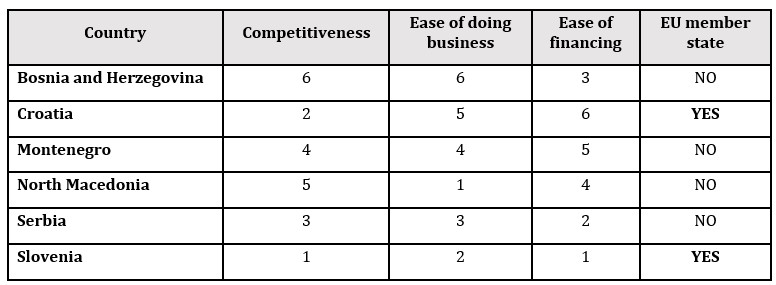
Source: World Economic Forum (2019), World Bank (2019), United Nations (2019). Authors’ calculation and representation.
Control Variables
Industry. In this paper the sample is divided between manufacturing and service SMEs. Dummy variable is composed to account for and control the difference between manufacturing and service SMEs. 537 SMEs in the sample are services and 426 are manufacturing SMEs.
Education. Education is used as a control variable, as owner or CEO’s education might influence the access to social contacts, i.e. strategic networking. Namely, strategic networking among SMEs is conducted by individuals working in those companies. There might be differences in contacts of person only with primary education (6 respondents from the sample), secondary education (162 respondents from the sample), higher education (528 respondents from the sample), MBA or equivalent degrees (210 respondents from the sample) and PhD (57 respondents from the sample).
Position. Position is used as a control variable for the same reason as education variable. Position could be owner (509 respondents from the sample), CEO (175 respondents from the sample), or management (279 respondents from the sample).
Independent Variables
Strategic networking. Strategic networking in our analysis is a second-order latent variable, composed of three first-order latent variables and 15 items. Strategic networking scale is composed of: commitment (Allen & Meyer, 1990), trust (Garbarino & Johnson, 1999), reputation (Hansen et al., 2008), communication (Sivadas & Dwyer, 2000), and cooperation (Eriksson & Pesämaa, 2007). Principal components’ analysis with varimax rotation extracted 3 components for strategic networking based on eigenvalues greater than 1: (1) Trust and reputation (6 items) formed the first component, (2) Communication and cooperation (6 items) formed the second component, and (3) Commitment (3 items) formed the third component. From the three mentioned variables, a second-order latent variable is composed. Kaiser-Meyer-Ohlin’s measure of sampling adequacy is 0.574; Bartlett’s test of sphericity obtains a p-value = 0.000. All communalities are greater than 0.5, and 60.19% of total variance is explained by component loadings. Cronbach’s alpha is 0.661 for the three items. Consequently, principal axis factoring was performed to save the variables extracted from exploratory factor analysis to confirmatory factor analysis. This analysis examines the effect of the first order latent variables, which are also antecedents of strategic networking as proposed by the literature: (1) Trust and reputation, (2) Communication and cooperation, and (3) Commitment, as well as the second order latent variable Strategic networking, composed of the aforementioned three.
Size. SMEs are divided into three groups based on their sizes: micro SMEs (403 SMEs, 41.8% of the sample), small SMEs (392 SMEs, 40.7% of the sample) and medium (168 SMEs, 17.4% of the sample).
Results
Descriptive statistics are firstly presented, followed by results of the regression analysis. Table 2 shows descriptive statistics and cross-correlations between variables in the model. Descriptive statistics show mean and standard deviation of each variable.
Cross-correlations show statistically significant correlation between: (a) competitiveness and strategic networking, (b) competitiveness and size, and (c) ease of financing and strategic networking (Table 2). Among strategic networking antecedents, trust and reputation is not statistically significantly correlated with any of the dependent variables nor with the moderator, but only with the control variable industry. Communication and cooperation is statistically significantly correlated with competitiveness and ease of financing, while commitment is only significantly correlated with competitiveness.
Although there are statistically significant differences between SMEs’ strategic networking and membership in the European Union at 10% significance level (ANOVA: p – value = 0.070), SMEs from the European Union member states’ strategic networking have μ = – 0.080 and median = 0.07, and from Western Balkans μ = 0.040 and median = 0.160. As median is lower for the European Union member states than for SMEs from Western Balkans (0.07 < 0.0160), it can be stated that strategic networking is higher in Western Balkans (at the 10% significance level). In terms of trust and reputation variable, there is no statistically significant difference between the European Union and non-EU member states (ANOVA: p – value = 0.739). In terms of communication and cooperation, there is statistically significant difference between the European Union and non-EU member states at 10% significance level (ANOVA: p – value = 0.071); while for commitment, statistically significant difference between the European Union and non-EU member states is at 5% level of significance (ANOVA: p – value = 0.021).
Results of the regression analysis are primarily tested for multicollinearity and heteroskedasticity. Variance inflation factor (VIF) in all models is close to 1, reflecting no evidence of existence of multicollinearity in the models. The Breusch-Pagan test is used to examine the presence of heteroskedasticity of the error terms in the model. The results indicated the presence of heteroskedasticity of the error term in the model (p-value < 0.000). In order to correct for heteroskedasticity, which could present problems and show spurious regression results, weighted least squares regression is used. Individual countries are used as weights. Repeated Breusch-Pagan test for heteroskedasticity confirmed that the heteroskedasticity is no longer an issue (p-value = 0.065). Therefore, weighted least squares are used in this analysis. Results of the weighted least squares are presented in Tables 3 to 6.
Model 1 represents a model only with control variables; Model 2 adds the effect of strategic networking; Models 3 to 5 comprise control variables and strategic networking antecedents individually: trust and reputation, communication and cooperation, and commitment, respectively. Model 6 comprises control variables and the effect of firm size. Table 4 presents: (a) Model 7, which includes control variables, size and strategic networking, (b) Model 8 and 9 include control variables, size and strategic networking antecedents: communication and cooperation, and commitment, respectively on Competitiveness as a dependent variable, while Models 13 and 14 present the effect of control variables, size and strategic networking (Model 13) and cooperation and communication (Model 14) on Ease of financing. Trust and reputation variable was left out of the models as the effect of trust and reputation was insignificant for all dependent variables. None of the independent variables had a significant effect on Ease of doing business. Hence, in the subsequent analysis, the dependent variable Ease of doing business was left out of the models. Models 10, 11 and 12 show the interaction effect of firm size on the relationship between independent variable and Competitiveness, while Models 15 and 16 present the interaction effect of firm size on the relationship between independent variables and Ease of financing.
Table 2: Descriptive statistics and cross-correlations

Note: *** p – value < 0.001 ** p – value < 0.01 * p – value < 0.05 † p – value < 0.1
Source: Authors’ calculation.
Table 3: Effect of firm size and strategic networking and its antecedents on institutional environment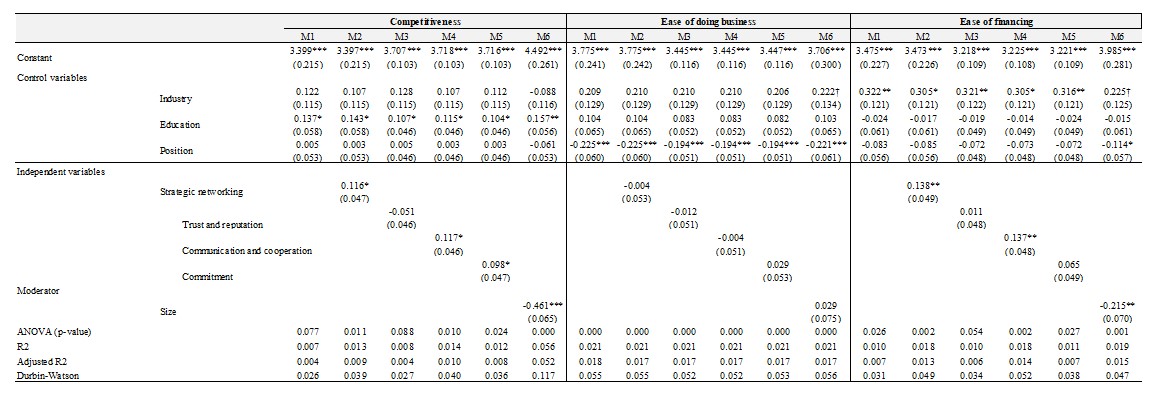
Note: *** p – value < 0.001 ** p – value < 0.01 * p – value < 0.05 † p – value < 0.1
N = 963. Standard errors in parentheses. Weighted least squares weight based on countries.
M1 represents a model only with control variables. M2 includes control variables and strategic networking; M3 includes control variables and trust and reputation. M3 contains control variables and communication and cooperation. M5 incorporates control variables and commitment. M6 includes the effect of control variables and size.
Table 4: Effect of firm size and strategic networking and its antecedents on institutional environment
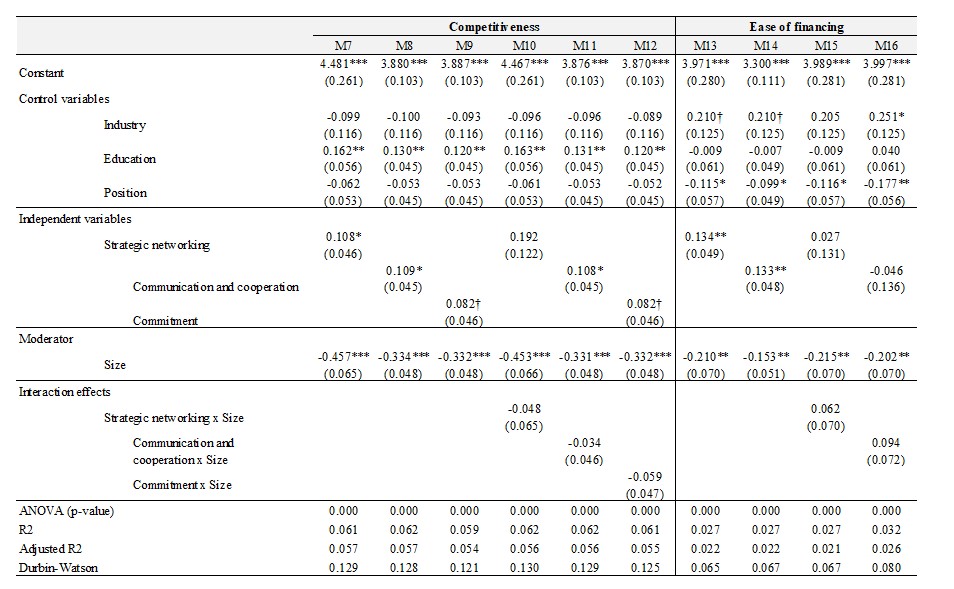
Note: *** p – value < 0.001 ** p – value < 0.01 * p – value < 0.05 † p – value < 0.1
N = 963. Standard errors in parentheses. Weighted least squares weight based on countries.
Results of the weighted least squares regression indicate that a unit increase in strategic networking increases competitiveness mean by 0.11, while a unit increase in SME size decreases a mean perception of national competitiveness by 0.46 (Table 4). In terms of strategic networking antecedents, a unit increase in communication and cooperation increases a mean perception of national competitiveness by 0.11 and a unit increase in SME size decreases a mean perception of national competitiveness by 0.33. Finally, a unit increase in commitment increases a mean perception of national competitiveness by 0.08 and a unit increase in SME size decreases a mean perception of national competitiveness by 0.33.
Strategic networking and SME size do not statistically significantly affect ease of doing business. Strategic networking increases the proportion of SMEs with a loan or line of credit, i.e., ease of financing, mean by 0.13, while a unit increase in SME size decreases a mean of SMEs with a loan or a line of credit by 0.21. As strategic networking and SME size do not influence ease of doing business rank, moderation effect of firm size and strategic networking on institutional environment is tested only for dependent variables: competitiveness and ease of financing. Similarly, a unit increase in communication and cooperation increases the average value of ease of financing by 0.13, while a unit increase in firm size decreases the average value of ease of financing by 0.15.
Lastly, the interaction effect of firm size and strategic networking and its antecedents on competitiveness (Table 5) and ease of financing (Table 6) were analysed to inspect possible differences between the European Union member states and non-European Union member states as they proved to be insignificant for the whole sample (Table 4). The results in Tables 5 and 6 add to the ANOVA analysis, which was previously pointed out.
Table 5: Effect of firm size and strategic networking and its antecedents on competitiveness in the EU and non-EU member states
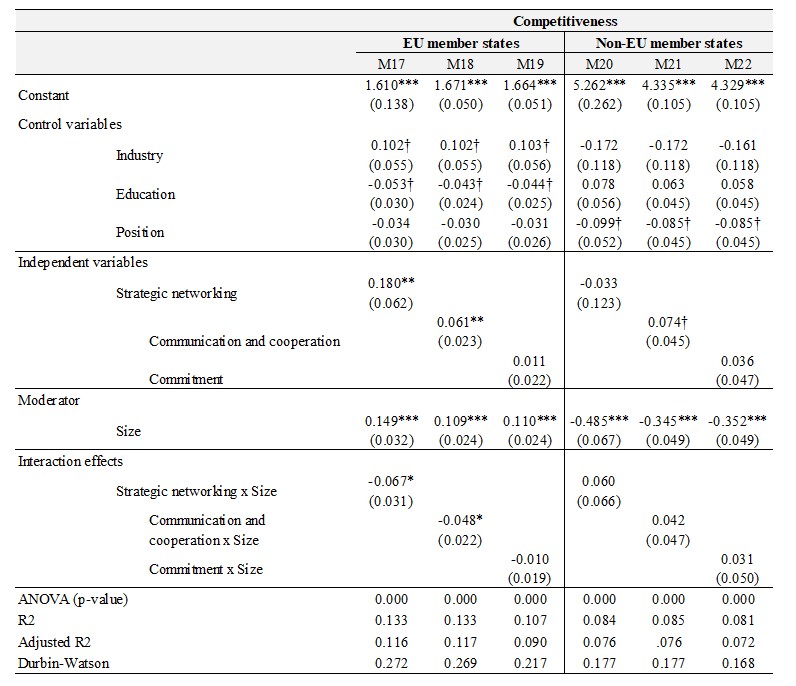
Note: *** p – value < 0.001 ** p – value < 0.01 * p – value < 0.05 † p – value < 0.1
N = 963. N (EU) = 322. N (non-EU) = 641. Standard errors in parentheses. Weighted least squares weight based on countries.
Size statistically significantly and negatively affects the relationship between strategic networking and its antecedent communication and cooperation and perception of national competitiveness only in the European Union member states (Table 5). The interaction effect of size and strategic networking or size and communication and cooperation does not statistically have significant effect on the perception of national competitiveness of the non-European Union member states. There is no moderation effect of size and commitment of commitment-competitiveness relationship.
Table 6: Effect of firm size and strategic networking and its antecedents on ease of financing in the EU and non-EU member states
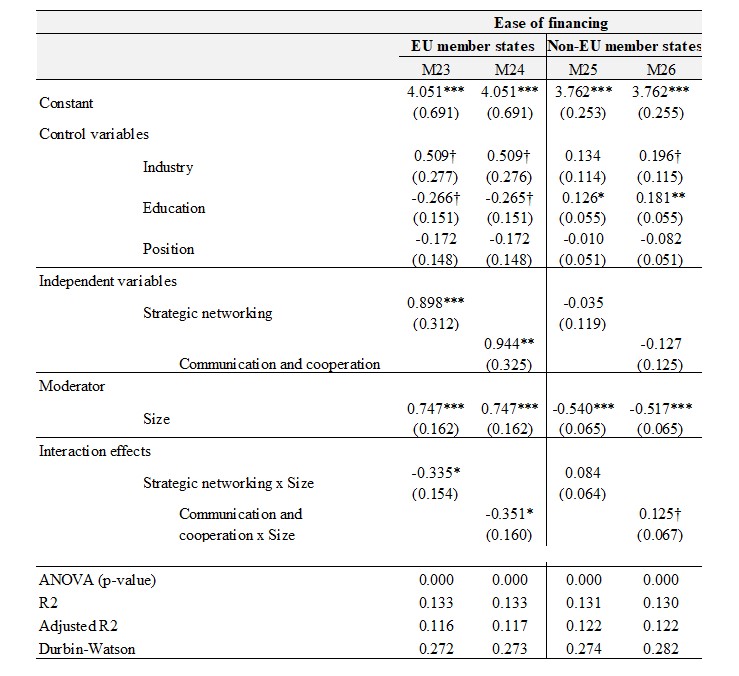
Note: *** p – value < 0.001 ** p – value < 0.01 * p – value < 0.05 † p – value < 0.1
N = 963. N (EU) = 322. N (non-EU) = 641. Standard errors in parentheses. Weighted least squares weight based on countries.
Moderation effect of SME size and strategic networking in the relationship between strategic networking and ease of financing is only significant for the European Union member states (Table 6). The same is true for the moderation effect of SME size and communication and cooperation.
As SME size dampens a positive relationship between strategic networking (antecedents) and competitiveness, and strategic networking (antecedents) and ease of financing, Figure 1 illustrates the interaction effect of SME size and strategic networking (antecedents) on the relationship between strategic networking (antecedents) and perceptions of institutional environment: (i) national competitiveness and (ii) ease of financing.

Fig 2. Moderating effect of firm size on the strategic networking and its antecedents-institutional environment relationships
Source: Authors’ representation.
Both Figure 1a and 1b show that larger SMEs (stripped line) tend to experience smaller positive effects of strategic networking (antecedent: communication and cooperation) on both competitiveness and ease of financing, meaning that strategic networking (antecedent: communication and cooperation) has a lower effect on national competitiveness and ease of financing for larger SMEs. This finding is only relevant for the European Union member states and not for the SMEs from Western Balkans’ countries.
Table 7: Summary of hypotheses testing
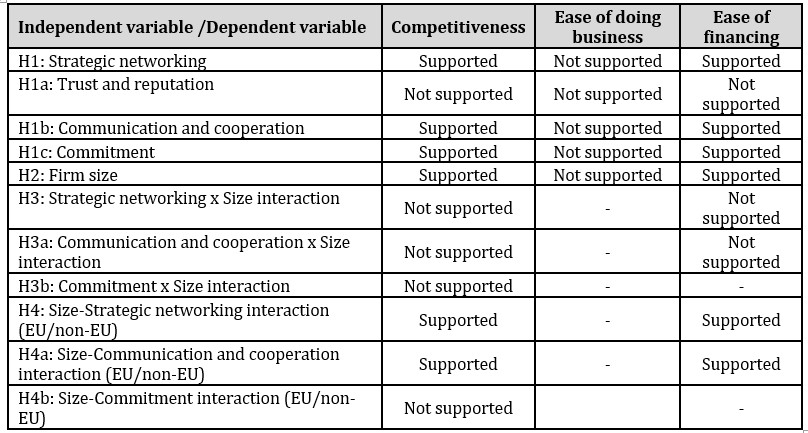
Source: Authors’ representation
Conclusion
The aim of this paper was to extend the study of the relationship between strategic networking and institutional environments of Southeast European countries. It examined how the strategic networking antecedents: (1) trust and reputation, (2) cooperation and communication, and (3) commitment, impact institutional quality: (a) competitiveness, (b) ease of doing business, and (c) ease of financing. The results show that cooperation and communication positively affect competitiveness and ease of financing, while commitment positively affects competitiveness. SME size served as a moderator variable, which did not exhibit any statistically significant effect between independent and dependent variables. The sample was further divided between the European Union member states (Croatia and Slovenia) and non-European Union member states, i.e., Western Balkan countries (Bosnia and Herzegovina, Montenegro, North Macedonia and Serbia). The only exception was a negative moderating effect of SME size on the relationship between communication and cooperation on one side and competitiveness and ease of financing on the other side, in the sample of the European Union member states. Namely, an increase in SME size dampens the effect of communication and cooperation on both competitiveness and ease of financing. Decrease in the effect of communication and cooperation on competitiveness and ease of financing can be attributed to the better regulatory environment and functioning of institutions in the European Union member states, while strategic networking does not influence neither competitiveness nor ease of financing in Western Balkans. SMEs from Western Balkans have higher strategic networking which is important in their institutional environment and maybe exactly because it is higher than strategic networking of SMEs from the European Union member states, it does not affect neither competitiveness nor ease of doing business. Namely, the role of strategic networking as an informal institution diminishes, as formal institutions strengthen, i.e. the substitutive role of informal and formal institutions.
Policy implications include the significant effects that cooperation and communication impose on institutional environments, i.e., competitiveness and ease of financing. Communication and cooperation have a statistically significant positive effect on both competitiveness and ease of financing in the sample of the European Union member states, and insignificant in the sample of Western Balkan countries. SME size statistically significantly affects competitiveness and ease of financing in the European Union member states, and negatively in Western Balkan countries. As the results showed, existent institutional setting within the European Union expressed through various rules and regulations allows strategic networking to positively influence changes in the national competitiveness and ease of financing. On the other hand, this is not the case for the countries of Western Balkans where their existent institutional setting depicted with the lower level of rules and regulations demonstrates no effect of strategic networking neither on national competitiveness nor on ease of financing. Therefore, future research should inspect details of this occurrence and compare them to similar research in the field.
There are several limitations related to the methodology of this study. Firstly, this research has been conducted as a cross-sectional study at a specific period in time. Secondly, even though a large sample size of SMEs (N = 963) has participated in this research, unfortunately the response rate is not very high, about 11%, therefore future research could benefit from the larger sample size. Furthermore, regardless of the fact that all six countries covered in this research originated from the semi-identical institutional environment before the 1990s, various diverse religious and cultural aspects within such geographical area could have strong impact and implications on the obtained results. Therefore, future research should focus on observing and inspecting the interrelations of religious and cultural differences between observed nations and their effect on SMEs’ strategic networking processes and interstices.
References
- Ahlstrom, D. and Bruton, G. D. (2006), ‘Venture capital in emerging economies: Networks and institutional change,’ Entrepreneurship theory and practice, 30(2), 299-320.
- Allen, N. J, and Meyer, J.P. (1990), ‘The Measurement and antecedents of affective, continuance and normative commitment to the organization,’ Journal of Occupational Psychology 63 (1), 1–18. https://doi.org/https://doi.org/10.1111/j.2044-8325.1990.tb00506.x.
- Battilana, J., and Casciaro, T. (2012), ‘Change agents, networks, and institutions: A contingency theory of organizational change,’ Academy of Management Journal, 55(2), 381-398.
- Battilana, J., Leca, B., and Boxenbaum, E. (2009), ‘How actors change institutions: towards a theory of institutional entrepreneurship,’ Academy of Management Annals, 3(1), 65-107.
- Bruszt, L. (2002), ‘Making markets and eastern enlargement: diverging convergence?’ West European Politics, 25(2), 121-140.
- Carson, D., Gilmore, A. and Rocks, S. (2004), ‘SME marketing networking: a strategic approach,’ Strategic Change, 13(7), 369-382. https://doi.org/10.1002/jsc.695
- Cohen, S. I. (2014), ‘Different institutional behavior in different economic systems: Theory and evidence on diverging systems worldwide,’ Economic Systems, 38(2), 221-242.
- Connelly, S., Bryant, M. and Sharp, L. (2020), ‘Creating legitimacy for citizen initiatives: Representation, identity and strategic networking,’ Planning Theory & Practice, 21(3), 392-409. https://doi.org/10.1080/14649357.2020.1776892
- Curran, J., Jarvis, R., Blackburn, R. A. and Black, S. (1993), ‘Networks and small firms: constructs, methodological strategies and some findings,’ International Small Business Journal, 11(2), 13-25. https://doi.org/10.1177/026624269301100202
- Donckels, R. and Lambrecht, J. (1995), ‘Networks and small business growth: an explanatory model,’ Small Business Economics, 7(4), 273-289. https://doi.org/10.1007/BF01108617
- Eckenhofer, E. M. (2011), ‘Outlining the benefits of strategic networking,’ Journal of Systems Integration, 2(4), 70-86. http://dx.doi.org/10.20470/jsi.v2i4.104
- Eriksson, P. and Pesämaa, O. (2007), ‘Modelling procurement effects on cooperation,’ Construction Management & Economics 25 (8), 893–901. https://doi.org/10.1080/01446190701468844.
- Fayoyin, A. (2017), Media advocacy and strategic networking in transforming norms and policies, Citizenship, Democracies, and Media Engagement among Emerging Economies and Marginalized Communities (pp. 347-370). Palgrave Macmillan, Cham. https://doi.org/10.1007/978-3-319-56215-5_14
- Garbarino, E. and Johnson, M. (1999), ‘The different roles of satisfaction, trust, and commitment in customer relationships,’ Journal of Marketing 63 (2), 70-87. https://doi.org/10.2307/1251946.
- Hansen, H., Samuelsen, B.M. and Silseth, P.R. (2008), ‘Customer perceived value in B-t-B service relationships: Investigating the importance of corporate reputation,’ Industrial Marketing Management, 37 (2), 206–17. https://doi.org/10.1016/j.indmarman.2006.09.001.
- Hardy, C. and Maguire, S. (2017), Institutional entrepreneurship and change in fields, The SAGE Handbook of Organizational Institutionalism, Greenwood, R., Oliver, C., Lawrence, T.B. and Meyer, R. E. (eds.), SAGE, 261-278.
- Human, S. E. and Provan, K. G. (1997), ‘An emergent theory of structure and outcomes in small-firm strategic manufacturing networks,’ Academy of Management Journal, 40(2), 368-403. https://doi.org/10.5465/256887
- Lawrence, T. B., Wickins, D. and Phillips, N. (1997), ‘Managing legitimacy in ecotourism,’ Tourism Management, 18(5), 307-316. https://doi.org/10.1016/S0261-5177(97)00020-4
- Maguire, S., Hardy, C. and Lawrence, T.B. (2004), ‘Institutional entrepreneurship in emerging fields: HIV/AIDS treatment advocacy in Canada,’ Academy of Management Journal, 47(5), 657-679.
- Makhija, M. V. and Stewart, A. C. (2002), ‘The effect of national context on perceptions of risk: A comparison of planned versus free-market managers,’ Journal of International Business Studies, 33(4), 737-756.
- Meyer, K. E. and Peng, M. W. (2016), ‘Theoretical foundations of emerging economy business research,’ Journal of International Business Studies, 47(1), 3-22.
- Miller, N. J., Besser, T. and Malshe, A. (2007), ‘Strategic networking among small businesses in small US communities,’ International Small Business Journal, 25(6), 631-665. https://doi.org/10.1177%2F0266242607082525
- Pelzer, P., Frenken, K. and Boon, W. (2019), ‘Institutional entrepreneurship in the platform economy: How Uber tried (and failed) to change the Dutch taxi law,’ Environmental Innovation and Societal Transitions, 33, 1-12.
- Peng, M. W. and Heath, P. S. (1996), ‘The growth of the firm in planned economies in transition: Institutions, organizations, and strategic choice’ Academy of Management Review, 21(2), 492-528.
- Raynard, M., Lu, F. and Jing, R. (2020), ‘Reinventing the state-owned enterprise? Negotiating change during profound environmental upheaval,’ Academy of Management Journal, 63(4), 1300-1335.
- Sivadas, E. and Dwyer, R.F. (2000), ‘An examination of organizational factors influencing new product success in internal and alliance-based processes,’ Journal of Marketing, 64 (1), 31–49. http://www.jstor.org/stable/3203389.
- Su, Z. (2020), ‘The co-evolution of institutions and entrepreneurship,’ Asia Pacific Journal of Management, 1-24.
- Thornton, S. C., Henneberg, S. C. and Naudé, P. (2013), ‘Understanding types of organizational networking behaviors in the UK manufacturing sector,’ Industrial Marketing Management, 42(7), 1154-1166. https://doi.org/10.1016/j.indmarman.2013.06.005
- Tiberius, V., Rietz, M. and Bouncken, R. B. (2020), ‘Performance analysis and science mapping of institutional entrepreneurship research,’ Administrative Sciences, 10(3), 69.
- Tracey, P., Phillips, N. and Jarvis, O. (2011), ‘Bridging institutional entrepreneurship and the creation of new organizational forms: A multilevel model,’ Organization science, 22(1), 60-80.
- United Nations (2019), Proportion of small-scale industries with a loan or line of credit dataset. [Online], [Retrieved August 13, 2021], https://www.sdg.org/datasets/undesa::indicator-9-3-2-proportion-of-small-scale-industries-with-a-loan-or-line-of-credit-percent-3
- Waeger, D. and Weber, K. (2019), ‘Institutional complexity and organizational change: An open policy perspective,’ Academy of Management Review, 44(2), 336-359.
- Wildeman, L. (1998), ‘Alliances and networks: the next generation,’ International Journal of Technology Management, 15(1-2), 96-108.
- Wincent, J. and Westerberg, M. (2005), ‘Personal traits of CEOs, inter-firm networking and entrepreneurship in their firms: Investigating strategic SME network participants,’ Journal of Developmental Entrepreneurship, 10(03), 271-284. https://doi.org/10.1142/S1084946705000215
- Whitley, R. (1999), Divergent capitalisms: The social structuring and change of business OUP Oxford.
- World Economic Forum (2019), The Global Competitiveness Report 2019. [Online], [Retrieved August 13, 2021], http://www3.weforum.org/docs/WEF_TheGlobalCompetitivenessReport2019.pdf











